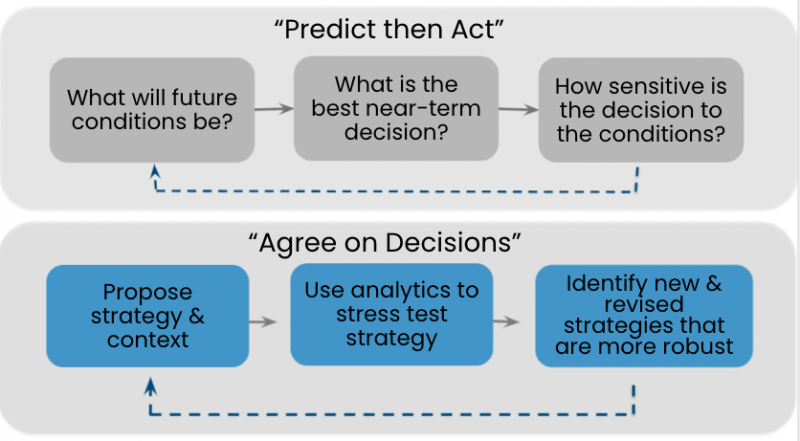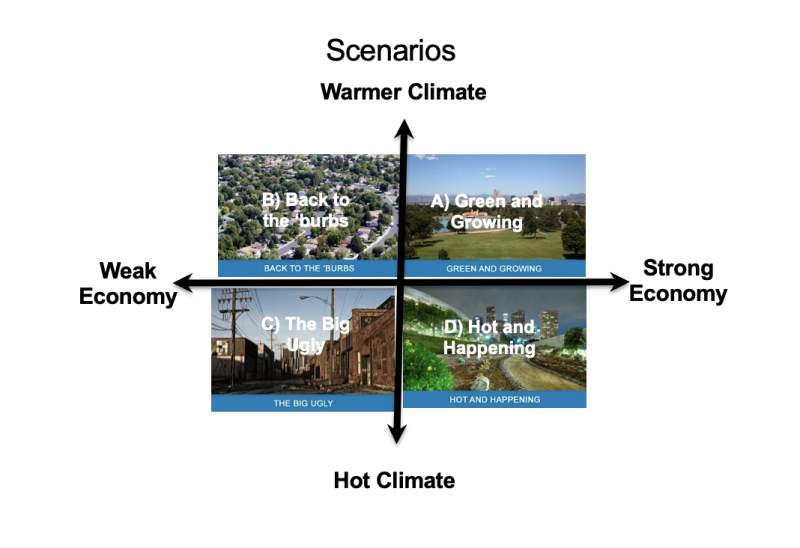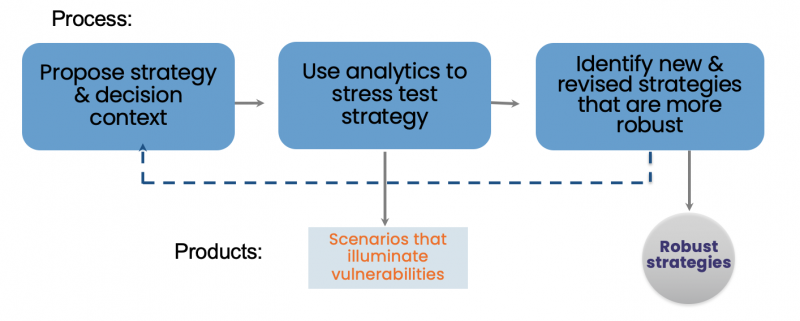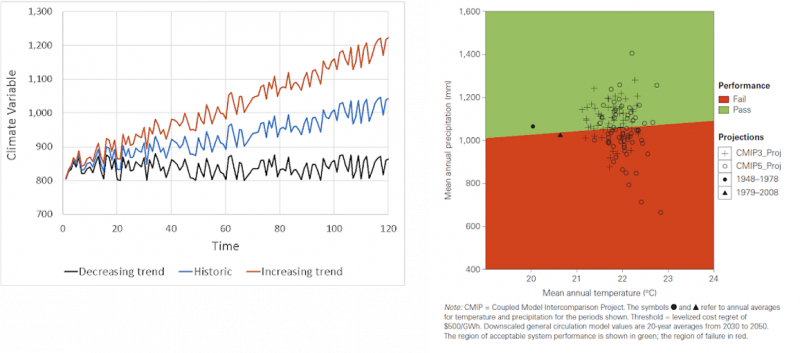Sections
Under the traditional model—called here “predict-then-act”—a planner makes a prediction of what future conditions will be, and, based on that prediction, they make a decision. This can be thought of as an optimization method, creating the maximum benefit for the minimal cost. These types of methods work well when uncertainties are small.
When uncertainties are deep, “predict-then-act” methods can break down. If decision makers develop their own form of “tunnel vision,” focusing on some concerns and motivations without seeing the big picture, they may fail to consider uncertainties in the future. This can lead to decision-making gridlock or unexpected outcomes.
Rather than seeking confidence in a specific model, under DMDU a planner is seeking confidence in a decision. DMDU begins with a proposed strategy and continues with stress tests of that strategy using multiple model runs to understand how it would perform under a range of plausible future conditions. Stress tests identify conditions under which a proposed strategy performs well or poorly, which then informs revised strategies that fill gaps. The process can be used iteratively to test new proposals until decision makers are confident that they have a set of robust options. Rather than seeking confidence in a specific model, under DMDU someone is seeking confidence in a decision. In this approach, important questions about deep uncertainty are asked to bolster confidence and investment in the decision and to eliminate a narrow view of the future:
- Can a robust and flexible strategy perform well under a range of future conditions?
- What uncertainties are most important?
- What actions do we need to take now?
- What actions can we postpone to the future?
Humans naturally tell stories, imagine each other’s experiences, contemplate potential explanations, and reflect on moral dilemmas. Shared experiences or novel insights can provide perspective and help us anticipate, prepare for, and respond to challenging situations, such as water supply interruptions. The remainder of this lesson briefly introduces major concepts in DMDU, namely Scenario Planning, Adaptive Pathways, Robust Decision Making, and Decision Scaling.
Scenario planning is a widely used method of envisioning possible future conditions. The process involves four components:
- Identify a decision challenge;
- Identify factors over which you have no control and which bring uncertainty to the decision;
- Develop narratives describing scenarios; and
- Use scenarios to develop a robust adaptive plan.
For example, climate and economy could evolve across two gradients that define the four quadrants in the figure below. In the top right quadrant, under the best possible conditions, planners describe a “green and growing” future. The bottom left quadrant depicts a hot climate and weak economy and is labeled “The Big Ugly.” Mathematical models can encapsulate essential characteristics of each scenario and evaluate impacts to a system of interest.
Adaptive pathways, as a methodology, involves walking decision makers through contingency plans so that decisions can be made at critical points as conditions change in the future. One can build a timeline of critical decisions that need to be evaluated prior to tipping points when system performance would be compromised by factors such as climate, economy, demand, etc. which themselves will continue to change in the future.
Robust Decision Making (RDM) and decision scaling are iterative processes that involve extensive stakeholder input. These methods emphasize three features:
- Stress test strategies over many plausible paths into the future.
- Use the resulting database to identify conditions where strategies fail.
- Use this information to identify more robust strategies.
IMAGE REQUIRES SOURCE INFORMATION
Simulation is used to evaluate possible decisions under unique combinations of uncertainties, levers, and relationships. This is known as a vulnerability analysis or a stress test. By evaluating a range of strategies, planners can identify strategies that perform well over the broadest range of scenarios. That set of strategies is then considered “robust.”
Decision scaling focuses vulnerability analysis or “stress testing” on the climate components of a potential decision. Historic, observed conditions are typically used for one set of simulations. If a reliable statistically downscaled dataset is not available for evaluating climate change, planners can evaluate possible future climate conditions, such as warm, hot, dry, wet, and any combination of those or other factors. The potential future climate time series data allow planners to quickly evaluate the potential influence of climate change on system performance. Decision scaling provides a climate vulnerability analysis, without relying on extensive climate modeling. The figure below shows how planners can use decision scaling to quickly evaluate model performance under different climate scenarios.
Considering multiple futures, seeking robust plans, making plans flexible and adaptive, and using analytics to explore multiple futures can all be great ways to start bringing DMDU principles into practice in organizational planning.





